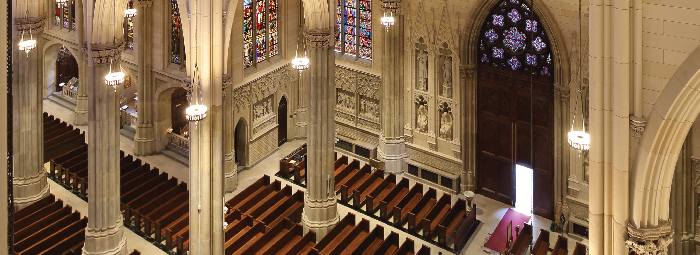
©2019 This excerpt taken from the article of the same name which appeared in High Performing Buildings magazine, vol. 12, no. 4.
About the Author
Jeffrey Murphy, FAIA, is a partner at MBB (Murphy Burnham & Buttrick Architects), an international architecture firm based in New York City.
The recent renovation of St. Patrick’s Cathedral in New York City—a prominent 1870s religious landmark designed by James Renwick Jr. and last modernized in 1949—reflects the vision of its trustees to advance not only ecological and economic value, but also social values held closely by “America’s Parish Church,” as it is known.
As the leadership told The New York Times, this centerpiece of the Archdiocese of New York would maintain its historic fabric even as major systems were upgraded and as the 138-year-old building “was going green.”
The project team, led by MBB Architects, included more than 25 consultants, engineers and specialists that directed a restoration of every square inch of historic fabric, employing the highest levels of preservation treatment and techniques. Design innovations were developed by the project team—including hidden stone tracery structure, a unique means of venting stained-glass—and new mechanical systems including a 10-well geothermal plant were threaded seamlessly through the building. Strategic architectural interventions, such as a soaring, minimalist glass wall dividing the main sanctuary from the Lady Chapel, enhance worship and functionality. Modern glass doors and improved architectural elements have created an energy-saving enclosure that enhances visitor comfort and views of historic interiors, stained glass, and structures.
The renovations improve material strength and durability, and the new HVAC system has replaced an inefficient array of steam radiators and 1960s-era condensers. On a pure performance level, St. Patrick’s Cathedral’s ambitious campaign of upgrades, retrofits and sensitive modern interventions have led to a 30% reduction in annual energy use. The work also stabilizes and protects significant historic fabric in a widely beloved religious destination that welcomes 5 million-plus visitors each year.
Big Legacy, Big Plans
The work on St. Patrick’s Cathedral took 11 years and, ultimately, about $177 million to transform a city block-sized campus of Gothic Revival architecture and park-like greenery. Formerly failing marble, plasterwork, and stained glass were in dire need of preservation measures to stabilize and improve the complex’s original fabric. The last full restoration of St. Patrick’s Cathedral occurred in the 1940s, with limited resources. In the more recent work, historic details and elements, long concealed or forgotten, have been restored or recreated with studied deference to Renwick’s neo-Gothic details and design intent.
New, unobtrusive glass doors at historic bronze portals on Fifth Avenue offer a metaphor for rejuvenating St. Patrick’s Cathedral, and improve enclosure performance while also opening its arms in a welcome for neighbors and millions of visitors. This is among the many architectural and engineering interventions designed to enhance visitor experience, yet create a minimalist intervention seeking to carefully integrate new systems into the historic fabric. New fan-coil units, for example, were custom-designed to fit within existing radiator enclosures.
Most evident in this regard is the quiet, low-impact geothermal system—among Manhattan’s largest ever—which obviated noisy, visible exterior cooling equipment and allowed for a more efficient use of space. The new system supports a variety of improvements focused on occupant comfort, and it mitigated local noise and pollution in Midtown Manhattan. The geothermal wells reach a depth of 2,200 ft into Manhattan’s bedrock to draw groundwater for heating and cooling—that’s six times as deep as the Cathedral’s iconic spires are tall.
Read the Full Article